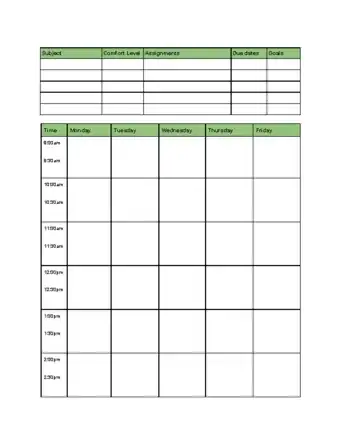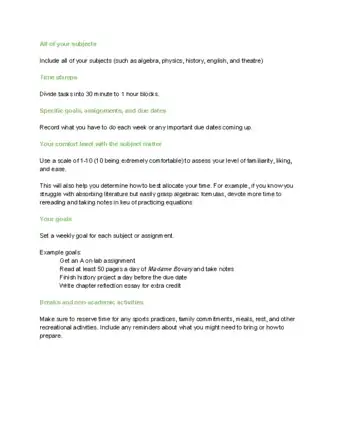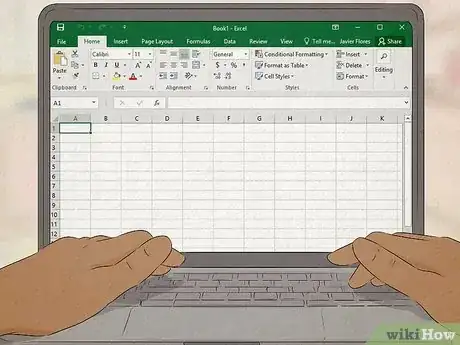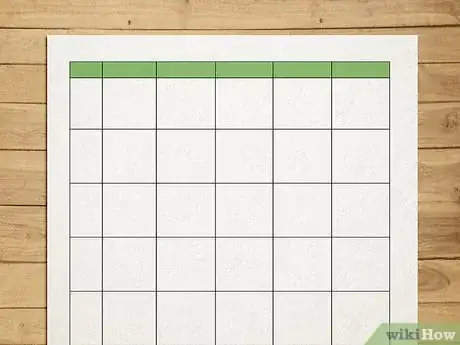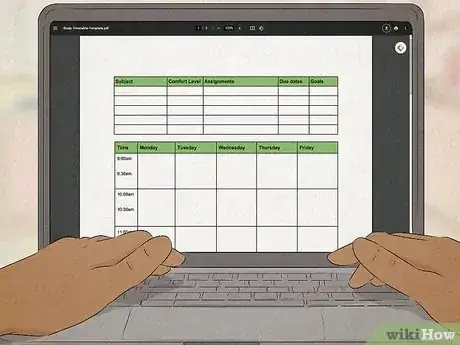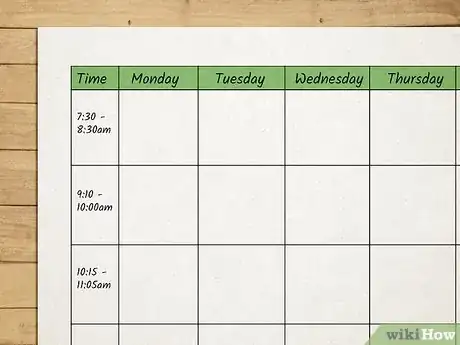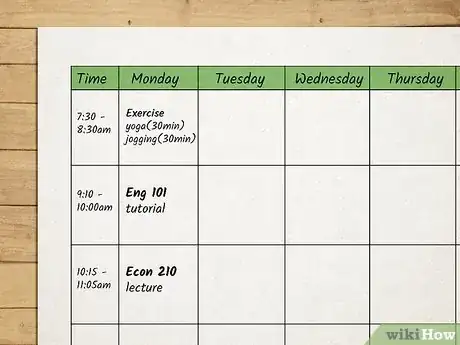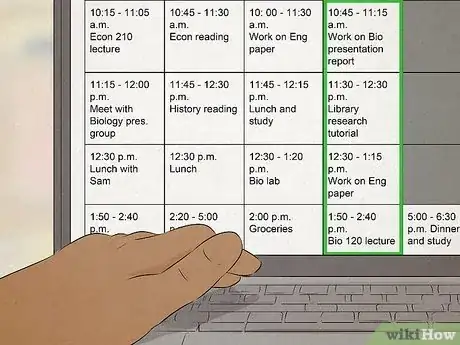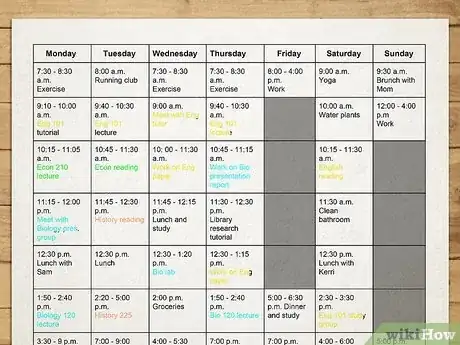This article was written by Alexander Ruiz, M.Ed. and by wikiHow staff writer, Madeleine Flamiano. Alexander Ruiz is an Educational Consultant and the Educational Director of Link Educational Institute, a tutoring business based in Claremont, California that provides customizable educational plans, subject and test prep tutoring, and college application consulting. With over a decade and a half of experience in the education industry, Alexander coaches students to increase their self-awareness and emotional intelligence while achieving skills and the goal of achieving skills and higher education. He holds a BA in Psychology from Florida International University and an MA in Education from Georgia Southern University.
There are 14 references cited in this article, which can be found at the bottom of the page.
wikiHow marks an article as reader-approved once it receives enough positive feedback. This article received 87 testimonials and 94% of readers who voted found it helpful, earning it our reader-approved status.
This article has been viewed 1,629,879 times.
A study timetable is a handy, inexpensive tool that can help you get control over your study time. Basically, a study timetable gives you a perspective of how much time you have to complete all your prioritized tasks, like exam prep for all your classes. If you want to get organized and feel motivated to get your work done, we'll teach you everything you need to know about study timetables. So, leap right into this straightforward article to unlock your full academic potential!
This article is based on an interview with our educational consultant, Alexander Ruiz. Check out the full interview here.
Things You Should Know
- Review the syllabi from all your classes to create the most detailed timetable.
- Set aside special blocks of time that are reserved for studying your material.
- Factor small breaks into your timetable so you'll be refreshed and stress-free.
- Revise your timetable whenever a new development, like extra credit, comes up.
Steps
Sample Timetable and List of Things to Include
Setting Up Your Timetable
-
1Review your current schedule to see how you spend your time. Before you create a study timetable that’s perfectly tailored for your academic goals, get a sense for how you’re running your life right now. For example, do you spend a ton of time socializing or unwinding with video games? While that’s perfectly fine, you might notice that you can repurpose some hours to master your class or ace a test.[1]
- Remember—any sacrifices you make are temporary. You'll be able to go back to your everyday routines after your big exam or assignment.
- Sometimes, you’ll have to fit your studying around some things that you do on a regular basis, like extracurriculars, chores, or exercise.[2]
- It’s totally fine if you take off some days to enjoy yourself. Just be sure to make up the difference later!
-
2Collect all the information you can about your class. Review your syllabus to see all the exams, group discussions, essays, and assignments you’ll be responsible for. If you accidentally tossed it, ask your teacher for another one. If your teacher uses an online platform, like Blackboard, scroll through it to familiarize yourself with the pace and general challenge level of your class.[3]
- For example, maybe your professor assigns a lot of small and super achievable assignments, like weekly reflection papers, and only gives one mid-term.
- On the other hand, your professor might be more tough and assign bi-monthly exams. Or, they may expect you to turn in multiple drafts of any essay.
- See which tasks are more time-consuming. For instance, maybe you’re a whiz at pre-lab assignments, but you need to dedicate a couple hours each day to quantum mechanics.
Advertisement -
3Decide which times are optimal for studying. Consider when your brain is alert and when you’re most energized. When it comes to reviewing your materials, are you a morning or a night person? After the sun rises and you chow down on a bowl of oatmeal, are you ready and raring to go? Or, do you like to eat dinner, wind down, and meticulously look over your notes? When you find out your “peak study hours,” you’ll be able to create the best schedule for yourself.[4]
- Look for times when you won't have any distractions—for instance, you might be completely free to study from 7 A.M. to 10 A.M. or 5 P.M. to 8 P.M.
-
4Create your timetable grid. Are you a big picture type of person? If so, you might want to make a study timetable that maps out a whole month. However, you may prefer to “chunk” your material and create a study timetable that outlines your week. If you are really hands-on, you might like to use a ruler, a pen, and highlighters to draw out your timetable on a piece of paper. However, you can also speed up the process by making a digital timetable on a spreadsheet or with an app.[5]
- Try out spreadsheet programs, like Microsoft Excel or Apple Numbers. Or, experiment with some of the templates that your word processor—like MS Word—offers.[6]
- Some apps specialize in study timetables—for instance “My Study Life” helps you record and track all of your exams and assignments.
- If you're frequently online or on your phone, a physical paper timetable might be the best option for you. You’ll be able to refer to it without getting distracted by your tech.
- You can also combine paper and digital formats: use your computer to print out a grid that you’ve already added days and times to, then print out as many as you like and fill them out by hand.
-
5Draw the grid for your timetable. A traditional timetable tracks all the days you’ll spend studying as well as the time you’ll allot for each task. Once you create a grid with plenty of squares (for example, a 7x8 grid), write the days of the week at the top. Once those squares are filled in, the rest can be used to block out times when you’ll study for tests, assignments, or presentations.[7]
- If you’re making a timetable by hand on paper, use regular notebook paper or blank paper and draw your lines with a ruler for a clean look.
- The biggest downside to the paper-and-pencil method is that it can be pretty labor intensive if you need to make tweaks on multiple pages.
- Your safest bet is to use a digital program, like Google Sheets. After all, you might end up adding more blocks on your timetable if your teacher assigns new material, like quizzes or extra credit assignments.
-
6Choose a timetable template that you'll use every week. If you’d like to streamline your process, design or download a timetable that you’ll print out and fill in every week. Create a batch of these timetables in one go based on the information you receive from your syllabus and your course management system, like Blackboard. All this prep will save you a lot of time in the long run.[8]
- Take into account big assignments or final exams and update your study schedule by adding blocks of times you'll use to study for them.
- Factor in extracurriculars that you identified earlier, like holidays or sports. Fill in squares to represent blocks of time in which you won’t be studying.
Filling in Your Timetable
-
1Block your study times. Aim for blocks of study time that are fairly long, such as 2–4 continuous hours. This will help you get into the groove of studying and make sure you're more productive with your time. Time-blocking is a tried and true tactic to eliminate distractions so you can dedicate all your attention to your coursework.[9]
- Have a day where you're super busy? That's totally fine—just look for a block of time that's available. Even 45 minutes can keep you ahead of the game when it comes to studying.
- If you have some classes that are really challenging for you, it's a good call to set aside more time to study for them. For example, if French is a breeze, squirrel away 1 hour for it. However, if you have to rack your brain over Statistics, devote a whole 4 hours to review the ins and outs of it.[10]
- Bear in mind that you don't have to force yourself to stay on task for 4 continuous hours without a single break—we'll cover that in the next step.
-
2Schedule time for breaks. Break are essential to your success. After all, you're not a robot, and no one, not even your teacher, expects you to work non-stop for hours on end. If you build breaks into your study schedule, you're more likely to overcome boredom and to return to your work feeling refreshed and energized.[11]
- Many experts recommend that you work for 45 minutes every hour, and then take a break for 15 minutes. Everyone is different, though, so experiment to find what works best for you.[12]
- If you think you thrive with regular breaks, or if you tend to get a little restless, try the "Pomodoro Method": during the block of time that you're studying, commit to 25 minute stretches of concentrated work, then take 5 minute breaks.[13]
- For an extra boost to your health, build in activity breaks—for example, go for a 15-minute walk or make use of a 5-minute break by doing a set of push ups, sit ups, or body weight deadlifts.
-
3Be as specific as possible. Remember how you gathered all your of assignments and syllabi? Now's the time to put them to use. Schedule blocks of time that represent when you'll study for all of your classes. Also remember to fill out squares on your grid to note which assignments and presentations you'll be responsible for. For instance, instead of just writing "English," jot down: "Create outline for essay on post-modernism." You'll have a clear picture of what you need to prioritize.[14]
- Things will change over time, of course, and something you planned 2 months ago may not apply anymore. If that's the case, use a pen to draw an "X" through any assignments or tests you no longer have to take.
- Homework's also great to add to your timetable. For example, if you always have 20 math problems to do each week, record that in your timetable.
- Scribble in new updates that come up, too. For example, if two teachers are offering extra credit opportunities, factor that into your study timetable.
-
4Schedule multiple subjects during each session. Keep in mind that it's totally okay to use one continuous block of study time to review concepts from different classes. For example, use a 4 hour block to review French vocabulary, chemical reactions, and business practices. Working on different subjects during a single session will keep you from getting completely burned out by intensely focusing on one subject and ending up with next to no energy to do anything else.[15]
- Of course, this can change once exam time rolls around and you need to devote all your energy to a single subject!
-
5Color code your timetable to keep track of all your classes. Color coding classes and responsibilities will help make your timetable easier to use and be easier on the eyes. You might be looking at this timetable a lot—make it your own! Who knows: you might end up enjoying the process of managing your studying time and sprucing up your timetable. Best case scenario? You'll see it as a fun and almost therapeutic activity that lets you get a little artistic.[16]
- You might want to use colored pencils if it’s on paper. Or you could highlight things on the computer and print in color.
- If you’re using an online-only app, you'll usually have to stick with the range of colors it provides (i.e., blue, green, orange, and pink).
- Consider an online program like Canva. You'll have tons of templates to choose from. You can even add fun digital stickers, like bubbling beakers to represent your Chemistry class.
- You can even buy some awesome and vibrant timetables on sites like Amazon or Etsy.
Using the Timetable
-
1Stick to the plans and obligations you agreed to. It might take some time for you to really get used to fitting your life around your timetable and taking it seriously without any deviations. Just give it a chance. Once it’s a part of your routine, it’s going to be a big help. Plus, think of it this way—it's a great tool to ensure you dominate your classes. When you ace all your tests and earn an awesome grade, so many doors will open up for you.[17]
- If an emergency comes up, take care of what you need to. Just be sure to find extra blocks of time later in the week to make up the difference.
- All that dedication gives you a great chance to treat yourself later. Grab some ice cream, phone some friends, or play some video games when you finish. After you're done with all your classes, you can even throw a little party.
-
2Relax whenever you make any tiny slip-ups. There's no reason to follow your timetable down to the exact minute. Look, if you start studying for Spanish at 5:05 P.M. instead of 5:00 P.M., it's not the end of the world. Just focus on finishing up all your most important tasks while also factoring in time for some rest and relaxation. Ultimately, a timetable's a little system to help you perform better in your classes. Base your time on it, but don’t worry about not following it to the tee.[18]
- If you want to, meditate, move around, or chat with a friend right before you jump into all your coursework. In fact, research suggests it's smart to unwind before all the hard work you'll do.[19]
-
3Revise your timetable if you need to adjust your study schedule. See what works and what doesn’t, and if something isn’t working, feel free to fix it. You already put effort into making the timetable—there’s no reason to scrap it when a few simple revisions could make it work well for you. While it's best to stick to your timetable, it's also important to update it if any there are any new developments.[20]
- If you have to make a lot of adjustments, a digital timetable might your best bet.
- If you prefer a physical copy, make sure your timetable has lots of empty squares so you can fill in new information.
- If you want a change, such as switching from a pen-and-paper timetable to one on an app, that's totally fine—it's important to do what feels sustainable for you.
Expert Q&A
-
QuestionCan I study 24 hours a day?
 wikiHowOur goal at wikiHow is to deliver trustworthy articles that engage our readers and meet their informational and emotional needs. For 15 years, we've committed to our step-by-step teaching model, and we continue to refine our content to create the best how-to experience on the Internet. We’ve helped millions of people solve problems, learn new skills, and feel supported in the ordinary and complex moments of life.
wikiHowOur goal at wikiHow is to deliver trustworthy articles that engage our readers and meet their informational and emotional needs. For 15 years, we've committed to our step-by-step teaching model, and we continue to refine our content to create the best how-to experience on the Internet. We’ve helped millions of people solve problems, learn new skills, and feel supported in the ordinary and complex moments of life.
The most trusted how-to site on the internet. Please don't attempt this. Studying for 24 hours is neither sustainable nor healthy. Instead, see if you can create blocks of time that add up to 24 hours. For example, study your materials for 2.5 hours from Monday-Friday over the course of 2 weeks. This is much easier to accomplish and won't negatively impact your physical or psychological health. Remember to always take care of yourself!
Please don't attempt this. Studying for 24 hours is neither sustainable nor healthy. Instead, see if you can create blocks of time that add up to 24 hours. For example, study your materials for 2.5 hours from Monday-Friday over the course of 2 weeks. This is much easier to accomplish and won't negatively impact your physical or psychological health. Remember to always take care of yourself! -
QuestionWhat can I do if I'm in an environment where there are tons of distractions and I can't avoid it? I live with a pretty noisy dormmate.
 wikiHowOur goal at wikiHow is to deliver trustworthy articles that engage our readers and meet their informational and emotional needs. For 15 years, we've committed to our step-by-step teaching model, and we continue to refine our content to create the best how-to experience on the Internet. We’ve helped millions of people solve problems, learn new skills, and feel supported in the ordinary and complex moments of life.
wikiHowOur goal at wikiHow is to deliver trustworthy articles that engage our readers and meet their informational and emotional needs. For 15 years, we've committed to our step-by-step teaching model, and we continue to refine our content to create the best how-to experience on the Internet. We’ve helped millions of people solve problems, learn new skills, and feel supported in the ordinary and complex moments of life.
The most trusted how-to site on the internet. We're sorry to hear about that setup! There's totally a solution for this, though, and it's possible to study in a noisy (or even chaotic) environment. Provided that you can't go to a quiet place, like a library, invest in some noise canceling headphones. If you've got a desk, consider moving it so your back faces your dormmate. That way, you won't be distracted by them so you can focus on your coursework.
We're sorry to hear about that setup! There's totally a solution for this, though, and it's possible to study in a noisy (or even chaotic) environment. Provided that you can't go to a quiet place, like a library, invest in some noise canceling headphones. If you've got a desk, consider moving it so your back faces your dormmate. That way, you won't be distracted by them so you can focus on your coursework. -
QuestionWhat kinds of foods can I eat if I need to pull an all-nighter and stay awake?
 wikiHowOur goal at wikiHow is to deliver trustworthy articles that engage our readers and meet their informational and emotional needs. For 15 years, we've committed to our step-by-step teaching model, and we continue to refine our content to create the best how-to experience on the Internet. We’ve helped millions of people solve problems, learn new skills, and feel supported in the ordinary and complex moments of life.
wikiHowOur goal at wikiHow is to deliver trustworthy articles that engage our readers and meet their informational and emotional needs. For 15 years, we've committed to our step-by-step teaching model, and we continue to refine our content to create the best how-to experience on the Internet. We’ve helped millions of people solve problems, learn new skills, and feel supported in the ordinary and complex moments of life.
The most trusted how-to site on the internet. First of all, if you do plan to pull an all-nighter, make sure that you still get a full night's rest. For teens, that means 8-10 hours of sleep, and for adults, 7-9 hours of sleep. That being said, if you'd like to "burn the midnight oil" and stay up longer to study all of your materials, try foods with a low glycemic index. That means that they'll release sugar slowly and keep you up longer (as opposed to quickly, which results in a sugar crash). Go for "low GI" treats like bananas, cherries, pineapples, whole wheat bread, oatmeal, or multigrain cereals. They'll help you stay alert and on track.
First of all, if you do plan to pull an all-nighter, make sure that you still get a full night's rest. For teens, that means 8-10 hours of sleep, and for adults, 7-9 hours of sleep. That being said, if you'd like to "burn the midnight oil" and stay up longer to study all of your materials, try foods with a low glycemic index. That means that they'll release sugar slowly and keep you up longer (as opposed to quickly, which results in a sugar crash). Go for "low GI" treats like bananas, cherries, pineapples, whole wheat bread, oatmeal, or multigrain cereals. They'll help you stay alert and on track.
References
- ↑ http://users.clas.ufl.edu/ufhatch/pages/02-teachingresources/study/
- ↑ Alexander Ruiz, M.Ed.. Educational Consultant. Expert Interview. 18 June 2020.
- ↑ Alexander Ruiz, M.Ed.. Educational Consultant. Expert Interview. 18 June 2020.
- ↑ http://www.studentbox.com.au/notes/Set_up_a_study_timetable
- ↑ https://youtu.be/JfZvWrUXhWY?t=245
- ↑ http://www.studentbox.com.au/notes/Set_up_a_study_timetable
- ↑ https://algonquincollege.libguides.com/studyskills/weeklySchedule
- ↑ https://www.excelsior.edu/article/study-plans/
- ↑ https://www.monash.edu/rlo/study-skills/preparing-for-exams/preparing-an-exam-study-timetable
- ↑ https://www.monash.edu/rlo/study-skills/preparing-for-exams/preparing-an-exam-study-timetable
- ↑ http://au.reachout.com/how-to-write-a-study-timetable
- ↑ http://www.studentbox.com.au/notes/Set_up_a_study_timetable
- ↑ https://learningcommons.ubc.ca/the-pomodoro-technique-study-more-efficiently-take-more-breaks/
- ↑ Alexander Ruiz, M.Ed.. Educational Consultant. Expert Interview. 18 June 2020.
- ↑ https://www.apa.org/gradpsych/2011/11/study-smart/
- ↑ https://open.lib.umn.edu/collegesuccess/chapter/2-3-organizing-your-time/
- ↑ https://www.unk.edu/blog/2018/11/how-to-stick-to-your-study-plan-during-the-holidays.php
- ↑ https://home.uark.edu/2020/02/the-dos-and-donts-of-time-management/
- ↑ https://health.cornell.edu/about/news/study-breaks-stress-busters
- ↑ https://open.lib.umn.edu/collegesuccess/chapter/2-3-organizing-your-time/
About This Article
To make a study timetable, start by making a list of all of your responsibilities, like your classes, job, chores, and extracurriculars. Then, use the list to figure out what times you're available to study. Once you know what times you have available, schedule 2-4 hour study sessions during those times. When you're scheduling your timetable, remember to include time for subjects you need to study every day as well as subjects you only need to study weekly or monthly. Also, keep in mind that you'll want to set aside more time for harder subjects. For more tips, like how to design your study timetable, scroll down!
